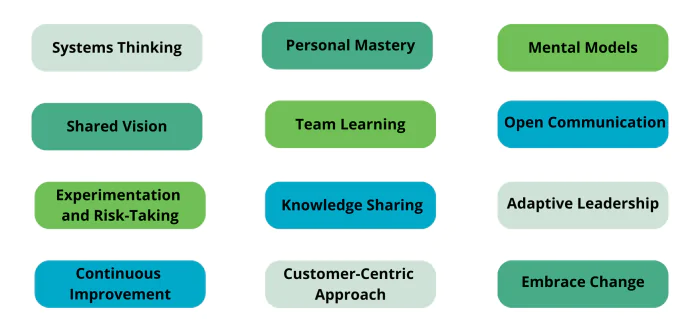Learning Organization
In an VUCA era marked by relentless technological advancements, shifting market dynamics, and unpredictable global challenges, the concept of a learning organization has emerged as a beacon of adaptability and resilience.
In a world where change is the only constant, organizations that prioritize continuous learning and growth are not merely surviving – they are thriving. Learning organizations represent a transformative approach to the way businesses and institutions operate, fostering a culture of innovation, agility, and adaptability.
Key Principles of a Learning Organization
A learning organization is built upon a set of fundamental principles that guide its culture and operations. These principles create an environment conducive to continuous learning, adaptation, and innovation.
Here are the key principles of a learning organization:

- Systems Thinking:
Learning organizations embrace systems thinking, which involves understanding how different components of an organization interact and influence one another. By viewing the organization as a complex system, they can make more informed decisions that consider the holistic impact on the entire organization. - Personal Mastery:
Personal mastery is the commitment to individual growth and development. In a learning organization, employees are encouraged and supported in their pursuit of excellence. This principle recognizes that when individuals continuously improve their skills and knowledge, the organization as a whole benefits (compare: Amazon Leadership Principles). - Mental Models:
Learning organizations encourage individuals to challenge their existing mental models or belief systems. By questioning assumptions and being open to new perspectives, employees can adapt to changing circumstances and contribute to a culture of innovation. - Shared Vision:
A shared vision is a unifying force within a learning organization. It provides clarity and purpose, helping employees understand how their work contributes to the organization's larger goals. When everyone works toward a common vision, it fosters alignment and collaboration. - Team Learning:
Learning organizations recognize the importance of collective learning within teams. Effective communication, knowledge sharing, and collaborative problem-solving are encouraged. Team learning promotes a culture of continuous improvement and innovation at the group level. - Open Communication:
Open and transparent communication is a cornerstone of learning organizations. Employees are encouraged to share their ideas, concerns, and feedback without fear of reprisal. This principle ensures that information flows freely throughout the organization. - Experimentation and Risk-Taking:
Learning organizations encourage experimentation and calculated risk-taking. They understand that innovation often involves trying new approaches, and not every experiment will succeed. Failures are viewed as opportunities for learning and improvement. - Knowledge Sharing:
Learning organizations value knowledge sharing. They create mechanisms and platforms for employees to share their expertise and experiences with colleagues. This sharing of knowledge accelerates learning and problem-solving across the organization. - Adaptive Leadership:
Leadership in a learning organization is adaptive rather than authoritative. Leaders facilitate learning, encourage innovation, and empower employees to take ownership of their growth and development. - Continuous Improvement:
The pursuit of continuous improvement is at the core of a learning organization. They regularly assess their processes, products, and strategies, seeking opportunities to enhance efficiency, quality, and effectiveness. - Customer-Centric Approach:
Learning organizations prioritize understanding and meeting the needs of their customers or stakeholders. They gather feedback, analyze data, and make adjustments to deliver greater value. - Embrace Change:
Learning organizations view change as an opportunity rather than a threat. They are adaptable and open to evolving their practices in response to changing circumstances and market dynamics.
By embracing these key principles, organizations can cultivate a culture of continuous learning, adaptability, and innovation, positioning themselves to thrive in an ever-changing world. Learning organizations are not just responsive to change; they actively seek it out and leverage it as a competitive advantage.
Conclusion about a Learning Organization
As technology and global challenges continue to shift and change, the idea of a learning organization stands out as a symbol of adaptability and resilience. These organizations prioritize constant growth and development by embracing key principles like personal mastery, systems thinking, and shared vision. By creating a culture of experimentation, innovation, and open communication, learning organizations not only navigate change but actively seek it out as a competitive advantage.
Leadership within these organizations is flexible, empowering individuals to contribute to the collective success. Rooted in a dedication to ongoing improvement and customer satisfaction, learning organizations don't simply respond to change – they proactively leverage it to thrive in an ever-changing world.

